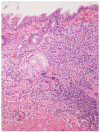Natural history of Helicobacter pylori infection
- PMID: 18396115
- PMCID: PMC3142999
- DOI: 10.1016/j.dld.2008.02.035
Natural history of Helicobacter pylori infection
Abstract
This report describes the modalities of chronic gastritis induced by Helicobacter pylori infection in different populations. The full gamut of lesions representing the precancerous cascade is very prevalent in populations of low socioeconomic background experiencing very high gastric cancer risk, as seen in the Latin American Andes Mountains. In populations of high socioeconomic standards and high cancer risk, such as Japan and Korea, the precancerous cascade predominates and "early" cancers are also diagnosed frequently. Some reports describe frequent corpus atrophy, not prominent in the former group. The so-called African enigma is seen in populations of low socioeconomic standards, usually living at low altitudes, with high prevalence of infection but low frequency of cancer and precancerous lesions. In populations in transition from high to low cancer risk, duodenal ulcer and antral non-atrophic gastritis are frequently seen. In affluent societies at low risk of cancer, such as Western Europe, Australia and North America, mild non-atrophic gastritis associated with low virulence Helicobacter pylori genotypes predominate. The varied phenotypes of gastritis may reflect secular changes in the ecology of our species.
Figures





References
-
- Tham KT, Peek RM, Jr., Atherton JC, Cover TL, Perez-Perez GI, Shyr Y, et al. Helicobacter pylori genotypes, host factors, and gastric mucosal histopathology in peptic ulcer disease. Hum Pathol. 2001;32:264–73. - PubMed
-
- Blaser MJ, Perez-Perez GI, Kleanthous H, Cover TL, Peek RM, Chyou PH, et al. Nomura A. Infection with Helicobacter pylori strains possessing cagA is associated with an increased risk of developing adenocarcinoma of the stomach. Cancer Res. 1995;55:2111–5. - PubMed
Publication types
MeSH terms
Grants and funding
LinkOut - more resources
Full Text Sources
Medical
Miscellaneous

